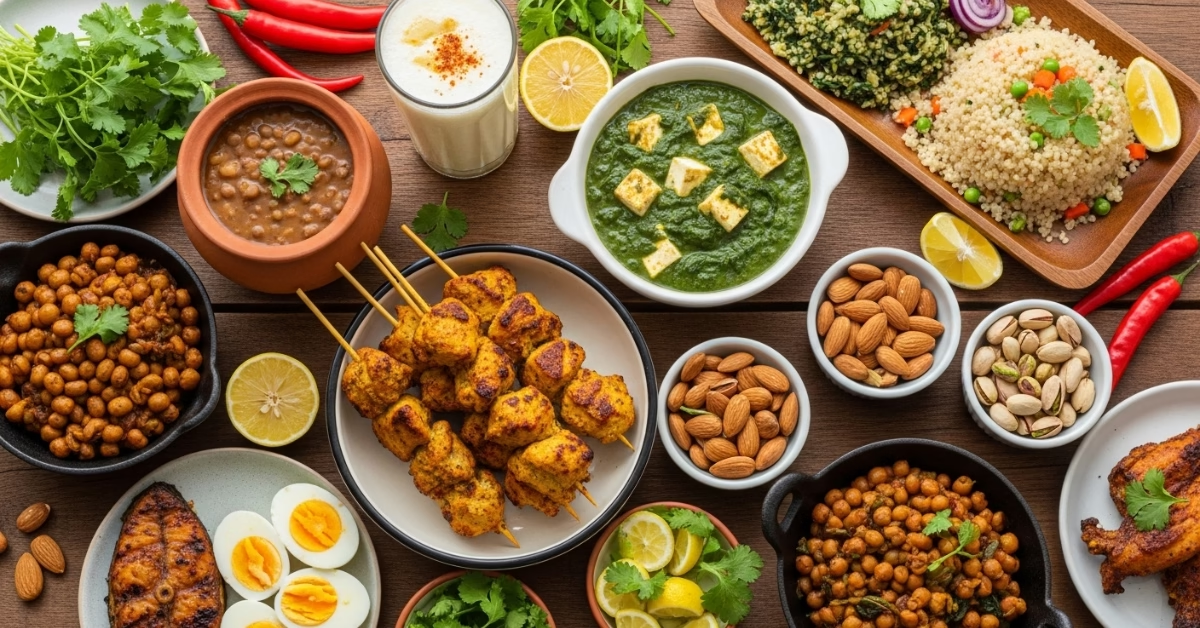Trying to eat more protein but tired of boiled eggs and bland chicken? Good news: your regular Indian kitchen already has everything you need. This easy-to-follow high protein Indian food chart lists both vegetarian and non-vegetarian foods you actually enjoy, plus a flexible one-day meal plan you can start tomorrow.
- Why Protein is Your Friend
- The Food Chart (Veg & Non-Veg)
- Sample 1-Day Meal Plan
- 5 Quick Tips to Hit Your Protein Goal
- More Indian Protein Sources
1. Why Protein is Your Friend
Protein isn’t just for body-builders. It:
- Rebuilds muscles after walking, lifting kids, or workouts
- Keeps you full longer, helping weight-loss
- Makes hair, skin, and nails stronger
- Supports immunity and hormones
According to the National Institute of Nutrition, Indians who maintain good muscle mass have lower risk of diabetes and heart disease.
2. Your High-Protein Indian Food Chart
All numbers are cooked/edible portion, approximate.
Vegetarian Protein Sources
| Food | Protein/100 g | Easy Serving |
|---|---|---|
| Lentils (any dal) | 7–9 g | 1 cup cooked = 12–18 g |
| Chickpeas (chana) | 15 g | 1 cup chole = 15 g |
| Kidney beans (rajma) | 9 g | 1 cup rajma = 15 g |
| Paneer | 18 g | ½ cup cubes = 14 g |
| Soy chunks | 52 g | 30 g dry = 15 g after soaking |
| Greek yogurt (hung curd) | 10 g | ¾ cup = 10 g |
| Almonds | 21 g | 20 nuts = 6 g |
| Oats | 12–13 g | ½ cup dry = 5–6 g |
| Quinoa | 8 g | 1 cup cooked = 4–8 g |
Non-Vegetarian Protein Sources
| Food | Protein/100 g | Easy Serving |
|---|---|---|
| Chicken breast | 30–31 g | 100 g grilled = 30 g |
| Eggs (whole) | 6 g each | 2 boiled eggs = 12 g |
| Fish (Rohu, Salmon) | 20–25 g | 1 medium piece = 20 g |
| Shrimp/Prawns | 20–25 g | 6–8 medium prawns = 20 g |
| Lean beef | 25–30 g | Palm-size steak = 25 g |
3. Sample One-Day High-Protein Indian Meal Plan
Mix and match; all protein values are rounded.
| Meal | Vegetarian Option | Protein | Non-Veg Option | Protein |
|---|---|---|---|---|
| Breakfast | 2 moong-dal chilla + bowl curd | 25 g | 2 scrambled eggs + toast | 15 g |
| Snack | Roasted chana (½ cup) | 7 g | 1 boiled egg + apple | 7 g |
| Lunch | Rajma curry + 1 cup brown rice | 20 g | Grilled chicken (100 g) + quinoa | 30 g |
| Evening | Greek yogurt + almonds | 10 g | Handful peanuts + chai | 6 g |
| Dinner | Palak paneer (100 g) + 2 multigrain roti | 25 g | Fish curry (100 g) + brown rice | 25 g |
4. Five Quick Tips to Hit Your Protein Goal
- Protein at every meal: Eggs at breakfast, dal at lunch, paneer at dinner.
- Combine smart: Rice + dal, roti + rajma, oats + milk = complete amino acids.
- Snack swap: Replace biscuits with roasted chana, peanuts, or Greek yogurt.
- Plan once, cook twice: Grill extra chicken, boil extra eggs for tomorrow.
- Stay hydrated: More protein means more water—keep a bottle handy.
5. More Indian Protein Sources
- Dairy: Milk (8 g/cup), cheese (25 g/100 g), sattu (20 g/100 g).
- Grains: Amaranth, buckwheat, ragi, bajra all add 6–12 g per cooked cup.
- Nuts & seeds: Chia, flax, sesame, pumpkin seeds—sprinkle on everything.
- Protein powders? ICMR says most Indians can meet needs with food. Supplements only if a dietitian prescribes them.
6. Key Takeaways
- You have 100+ tasty Indian protein foods to choose from.
- Include protein in every meal; aim for 0.8–1 g per kg body-weight daily.
- When in doubt, speak to a registered dietitian—especially if you have medical conditions.
Sources: National Institute of Nutrition, ICMR, Indian Food Composition Tables.
Faq
0.8–1 g per kg body-weight for general health; 1.2–1.6 g if you lift weights or are over 50.
Soy chunks – 52 g per 100 g dry (≈15 g after soaking). Paneer and lentils follow.
Yes. Combine lentils, paneer, soy, dairy, nuts, and whole grains to hit daily targets.
2 moong-dal chilla (≈14 g) + a glass of milk (8 g) = ~22 g for under ₹30.
Paneer gives 18 g/100 g but more fat; chicken breast gives 30 g/100 g with less fat. Rotate both.
